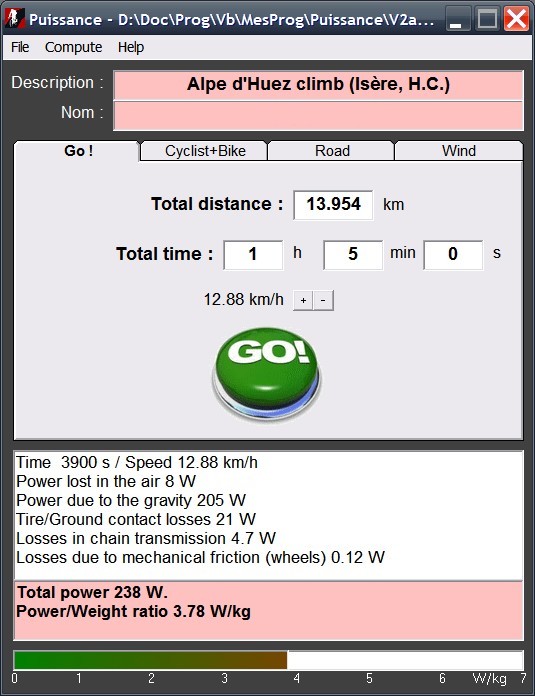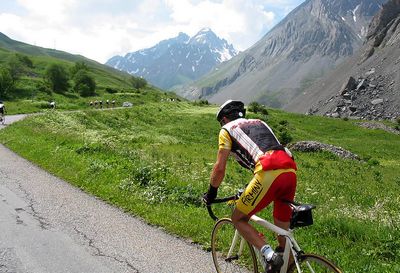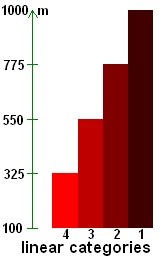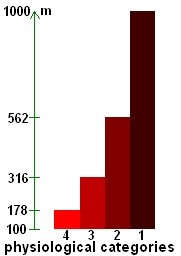|  |
|
|
I present here the current methods of classification of mountain passes for cyclists according to their difficulty, then I approach the subject in a scientific way to propose a new one closer to reality. | |||||||||||||||||||||||||||||||
Introduction to the classification of cycling passes:
Empirical methods and square rating of passes:When a journalist asks in 2014 the former professional rider Thierry Gouvenou, then responsible for choosing the route of the Tour de France,
how he ranks a climb, he talks about the praxis: if the race has already passed by a pass in the past, most of the time he do not change his ranking.
But he also does a calculation 1 : he multiplies the length of the road d by the square of his slope p,
then he can change the ranking according to the position of the pass in the course; sometimes he increases the ranking of a pass placed at the end of the stage, badly felt by tired organisms.
But what's interesting is the formula d.p2. Where does this thing come from? this is called the squared ranking.
The formula comes from the idea that the difficulty of a climb is proportional to both its slope p and its height difference h.
As h=p.d, we get well d.p2.
Guy Bodoin presents in detail this method in his climbs study 2:
it complicates the calculation by dividing the rise in parts then adding the score of each of them, which seems good to him when the ascent is irregular. 
Bodoin asserts, however, that his calculations are only relevant for the hardest climbs, those with a result of at least 750. Enough pseudo-scientific do-it-yourself, let's go on to the physical reality of the cyclist climbing a pass:Let's look at the problem as a physician. I will show you how to classify the passes in a rigorous way. So now here are some explanations on how I do this ranking, in the most scientific way possible, taking into account their real difficulty for cyclists, and demonstrating my results. Consider a cyclist riding an ascent with a constant slope p. He travels a distance d and increases his altitude by the value h:  To ride, the cyclist provides a power P during a time t. The difficulty of the climb, for him,
is to be able to provide this power during all this time: it is proportional to P, but also to t.
The difficulty of the pass is therefore proportional to P.t.
This value P.t is what physics defines as the work of the force that the cyclist provides to advance.  Let us represent the angle we are talking about the cosine:  Therefore:  By simplifying we get:  Conclusion: only three parameters are in the expression of the difficulty that the cyclist must face: its mass, the gravity and the difference in altitude. Mass and gravity do not depend on the topography of the pass; the only parameter in dependence is the elevation h. The negative sign means that it is a challenge to overcome by providing more positive work.
Note: this result is not surprising, since m.g.h is also the potential energy gained by the rider and his machine by mounting the pass. Proposed definition of cycling pass categories according to their difficulty:Taking into account what has just been demonstrated, I propose to define the categories of passes by taking into account only their altitude difference. I place the start of the passes out of category to a vertical drop of 1000 meters; this allows to correctly classify the Izoard, one of the hardest out of category passes, and Peyresourde, a very hard first category pass. I propose to place the beginning of the fourth category at a height of 100 meters, to not include almost flat roads. For categories 1, 2, 3 and 4, I propose to divide the interval from 100 to 1000 meters into four intervals, equal for the moment, which will correspond to the categories. Each of these categories will thus include an interval of 225 meters of altitude difference. This will give:
Note: the lower bounds are included in the range, upper bounds are excluded. However, the use of these intervals showed me that they are not good because their width, strictly equal, does not correspond to the physiology of the cyclist.
Indeed, when it climbs for example 800 meters, the difficulty he feels in the second half, to climb from 400 to 800 meters above the starting altitude,
is not the same as he felt in the first half, from 0 to 400 meters. Going away fresh and available at the meter zero he is, arrived at half of the coast,
after 400 meters, significantly more tired, because he already has 400 meters "in the legs"...
It is this cumulative effect that makes a c-category climb more difficult than a c-1 category, the next lower category.
The difference between two categories is not just a matter of time, because man is not a machine.
It's not directly because it takes longer than it is more difficult, it is because we are more tired and this fatigue accumulates
(partially, everything depends on the specific muscular mechanisms at play depending on the characteristics of the cyclist
and how he manages his effort by pressing more or less on the pedals).
These are the intervals I propose for final adoption. Simulations with the power calculation software that I developed
(see this dedicated page) have shown that, in most cases, with these intervals,
I obtain identical results as in professional cycling races.  Notes and references1.Sylvain Mouillard, Comment les cols du Tour de France sont-ils classés ?, liberation.fr, 2014. 2.Guy Bodoin, Dossier grimpées - France, 1000 ascensions à vélo en France, Club des cent cols, 2009. |
CommentsThere is no comment yet. Be the first to write one!
 |

|

|



